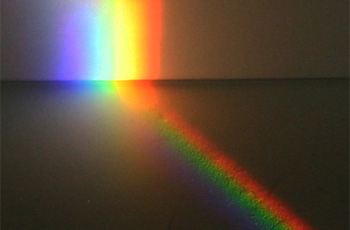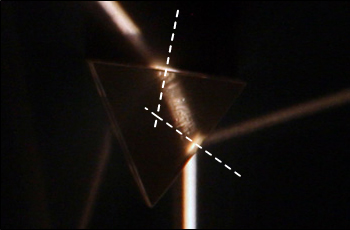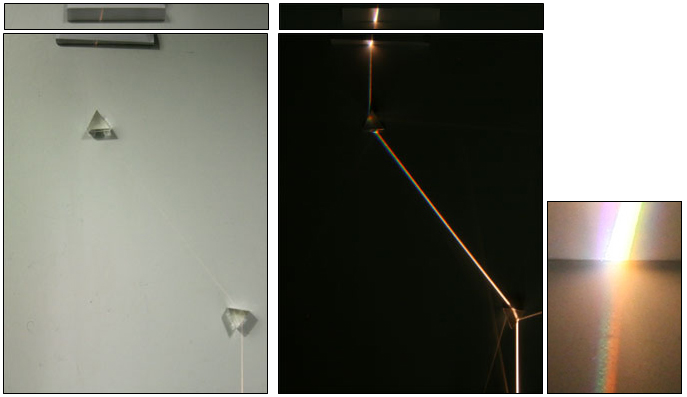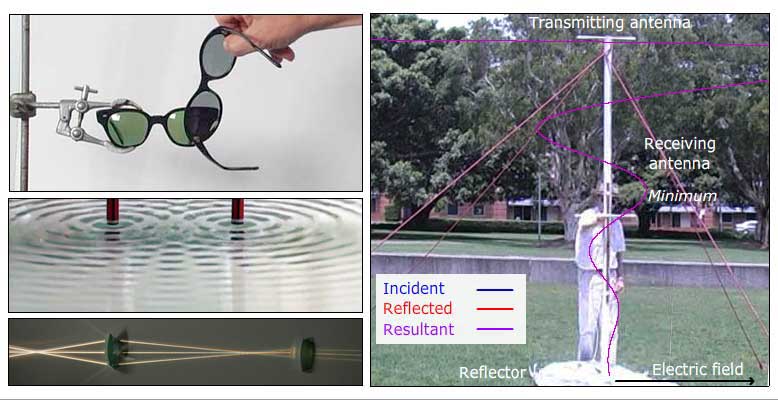Newton's prisms
Newton's prisms demonstrate dispersion: the division of white light into its component colours, and also their recombination to make white light. This page is one of the support pages for the multimedia tutorials The Nature of Light and Geometrical Optics.
A prism disperses white light into its component colours
The photograph at left shows the apparatus: a beam of light enters one side of a prism (bottom right) and leaves the other. It is refracted at both interfaces. The beam then arrives at a white screen (top left).
The photo at right has the same view, with the room lights turned off.
The next two photographs show Close-ups of refraction in the prism and the spectrum on the screen. But first, let's read from the Master. In the Philosophical Transactions of the Royal Society, 1671, p 682, Isaac Newton describes his observation of dispersive refraction thus:
"I procured a triangular glass prism, to try therewith the celebrated phaenomena of colours. And for that purpose having darkened my chamber, and made a small hole in the window shuts, to let in a convenient quantity of the sun's light, I place my prism at his entrance, that it might be thereby refracted to the opposite wall. It was at first a very pleasing diversion to view the vivid and intense colours produced thereby; but after a while applying myself to consider them more circumspectly, I was surprised to see them in an oblong form; which, according to the received laws of refraction, I expected would have been circular. They were terminated at the sides with strait lines, but at the ends, the decay of light was so gradual, that it was difficult to determine justly what was the figure; yet they seemed semicircular. Comparing the length of this coloured spectrum with its breadth, I found it about five times greater; a disproportion so extravagant, that it excited me to a more than ordinary curiosity of examining from whence it might proceed." |
Close-ups of the spectrum on the screen (left) and refraction in the prism (right).
 
The photo at left shows the projection of the emitted beam(s) onto a white screen, half a metre distant. Here we see that the violet and blue light has diffracted further than red. (There is a slight gap between the bottom of the screen and the board used as a base, so the alignment between the two prisms appears to be offset.)
The photo at right is a close-up of the experimental arrangement pictured above. The dashed lines show the normals to two surfaces of the prism and the refraction of the beam. At both refractions, the beam is closer to the normal in the glass than in the air. The beam is relatively broad so, in the photo at right, we do not yet see the dispersion into the component colours.
By the way, we have Newton to thank for the 7-coloured rainbow. Fisher (2015) writes "The medieval rainbow had just five colours: red, yellow, green, blue and violet. Newton added two more — orange and indigo — so that the colours would be “divided after the manner of a Musical Chord” (I. Newton in Opticks 4th edn, 127 (William Innys, 1730)".
|
Recombination into white light
 |
| Left: the two prisms and the screen. Middle: with the lab lights turned out. Right: the image on the screen. |
But what caused the spectrum? Was 'pure' white light somehow contaminated to make it coloured?
Reproducing Newton's famous experiment, we use a second prism to recombine the colours of the spectrum.
Let Newton continue: "And then I suspected, whether by any unevenness in the glass, or other contingent irregularity, thsee colours might be thus dilated. And to try this, I took another prism like the former, and so placed it, that the light, passing through them both, might be refracted contrary ways, and so by the latter returned into that course from which the former had diverted it. For, by this means, I thought the regular effects of the first prism would be destroyed by the second, but the irregular ones more agumented, by the multiplicity of refractions. The event was, that the light, which by the first prism was diffused into an oblong form, was by the second reduced into an orbicular one, with as much regularity as when it did not at all pass through them. So that, whatever was the cause of that length, it was not any contingent irregularity."
From this, Newton realised the limitations of refracting telescopes and went on to develop the polishing of mirrors and to invent the Newtonian or reflecting telescope. But there were diversions: "Amidst these thoughts I was forced from Cambridge by the intervening plague, and it was more than two years before I proceeded further."
|
Further information
These links are to the multimedia tutorials The Nature of Light and Geometrical Optics.

Links and further information
Chromatic dispersion, rainbows and Alexander's dark band
Dispersion and chromatic aberration
Lenses and images
Microscopes and magnifiers
Mirrors and images
Newton's prisms
Reflecting Newtonian telescope
Refracting telescope
Snells law and refraction
The multimedia tutorial Geometrical Optics also has a longer list of support pages
|

